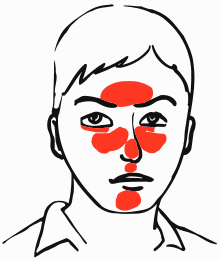Eczema:

The term eczema is broadly applied to a range of persistent skin conditions. These include dryness and recurring skin rashes that are characterized by one or more of these symptoms: redness, skin edema (swelling), itching and dryness, crusting, flaking, blistering, cracking, oozing, or bleeding. Areas of temporary skin discoloration may appear and are sometimes due to healed injuries. Scratching open a healinglesion may result in scarring and may enlarge the rash.
The cause of eczema is unknown but is presumed to be a combination of genetic and environmental factors.
The hygiene hypothesis postulates that the cause of asthma, eczema, and other allergic diseases is an unusually clean environment. It is supported by epidemiologic studies for asthma. The hypothesis states that exposure to bacteria and other immune system modulators is important during development, and missing out on this exposure increases risk for asthma and allergy.
While it has been suggested that eczema may sometimes be an allergic reaction to the excrement from house dust mites, with up to 5% of people showing antibodies to the mites the overall role this plays awaits further corroboration.
Researchers have compared the prevalence of eczema in people who also suffer from celiac disease to eczema prevalence in control subjects, and they’ve found that eczema occurs about three times more frequently in celiacdisease patients and about two times more frequently in relatives of celiac patients, potentially indicating a genetic link between the two conditions.
Roseacea:

There are four identified rosacea subtypes and patients may have more than one subtype present:
Erythematotelangiectatic rosacea: Permanent redness (erythema) with a tendency to flush and blush easily. It is also common to have small blood vessels visible near the surface of the skin (telangiectasias) and possibly burning or itching sensations.[citation needed]
Papulopustular rosacea: Some permanent redness with red bumps (papules) with some pus filled (pustules) (which typically last 1–4 days); this subtype can be easily confused with acne.
Phymatous rosacea: This subtype is most commonly associated withrhinophyma, an enlargement of the nose. Symptoms include thickening skin, irregular surface nodularities, and enlargement. Phymatous rosacea can also affect the chin (gnathophyma), forehead (metophyma), cheeks, eyelids (blepharophyma), and ears (otophyma). Small blood vessels visible near the surface of the skin (telangiectasias) may be present.
Ocular rosacea: Red, dry and irritated eyes and eyelids. Some other symptoms include foreign body sensations, itching and burning
Causes:
Triggers that cause episodes of flushing and blushing play a part in the development of rosacea. Exposure to temperature extremes can cause the face to become flushed as well as strenuous exercise, heat from sunlight, severe sunburn, stress, anxiety, cold wind, and moving to a warm or hot environment from a cold one such as heated shops and offices during the winter. There are also some food and drinks that can trigger flushing, including alcohol, food and beverages containing caffeine (especially, hot tea and coffee), foods high in histamines and spicy food. Foods high in histamine (red wine, aged cheeses, yogurt, beer, cured pork products such as bacon, etc.) can even cause persistent facial flushing in those individuals without rosacea due to a separate condition, histamine intolerance. Certain medications and topical irritants can quickly trigger rosacea. Some acne and wrinkle treatments that have been reported to cause rosacea include microdermabrasion and chemical peels, as well as high dosages of isotretinoin, benzoyl peroxide, andtretinoin. Steroid induced rosacea is the term given to rosacea caused by the use of topical or nasal steroids.
Medications
Corticosteroids and antibiotics have been used to control the symptoms. However, both can have short term and long term effects on body immune system and organ functions.
Acupuncture with herbs formula have been used in treating Eczema / Rosacea. Generally patients can achieve some level of improvement or stop the progress of the Eczema / Rosacea symptoms as long as improving his/her overall health conditions. Treatment normally requires 4-8 times visits spanning several weeks.
Recent Comments